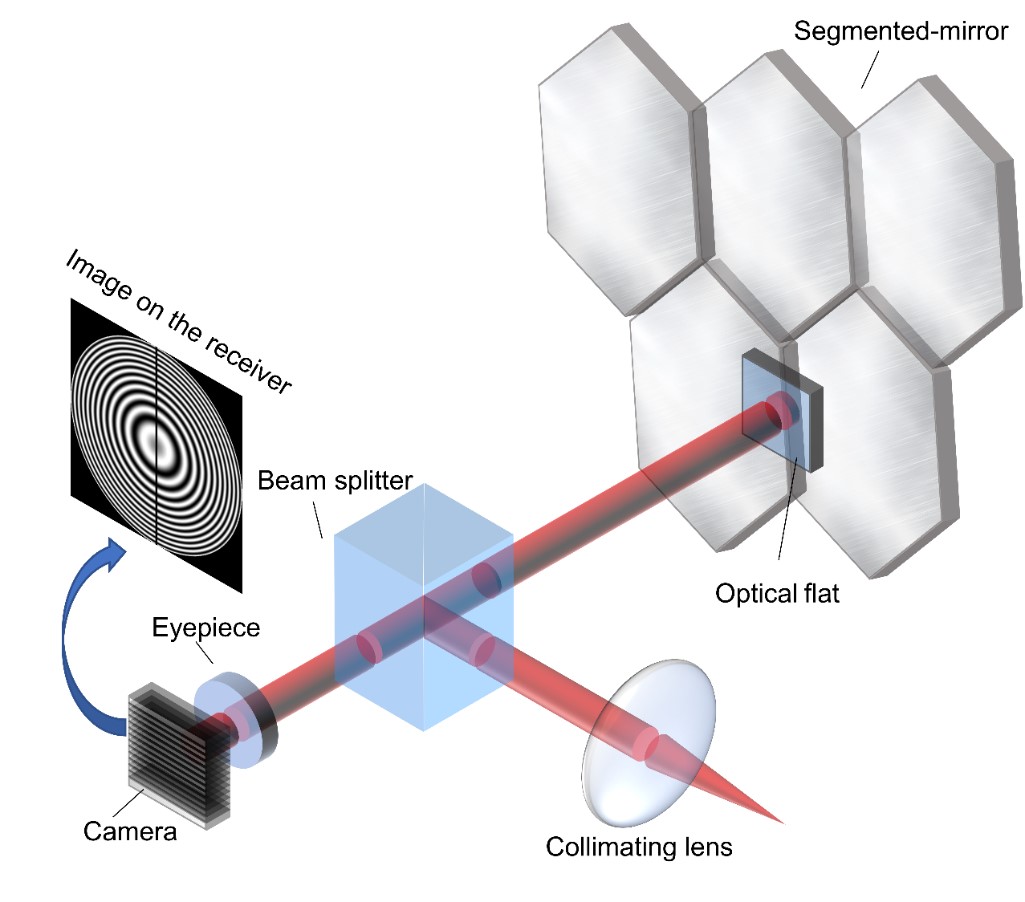Recently, the team of Dr. Heng Zuo, associate professor from Nanjing Institute of Astronomical Optics Technology (NIAOT), National Astronomical Observatories (NAOC), Chinese Academy of Sciences (CAS), proposed a new type of co-phase error detection method for segmented mirror telescopes, which is based on the principle of optical equal-thickness interference. This method not only eliminates some kinds of errors (such as temperature drift, time drift or electrical noise) in principle, but also simplifies the co-phase process of segmented mirror technology and moreover by this method the absolute co-phase error (piston and tip/tilt) between adjacent segments could be obtained in real time. The relevant research has been published as a cover article in Acta Optica Sinica, Volume 41, Issue 12, June 2021.
Figure 1 The cover of Acta Optics Sinica, Vol.41, No.12
The construction of optical telescopes with larger aperture is always the key research direction of astronomy and astronomical optics technology. However, with the increase in the aperture of mirror, it will also bring many technical problems, such as mirror’s manufacturing, processing and assembly. Segmented mirror active optics technology is the most effective way to break through the aperture limitation of the traditional monolithic mirror telescope, one large mirror could be perfectly segmented by many small size sub-mirrors. This method can not only solve the technical problems in manufacturing, but also save costs.
The Large Sky Area Multi-Object Fiber Spectroscopic Telescope (LAMOST), also known as Guoshoujing Telescope, is one of the National Major Scientific Projects. It was developed mainly by NIAOT, CAS. At present, it is the largest ground-based optical telescope with large field of view in China. It, as "King of Spectroscopy" and "World Spectroscopy Factory", is leading the international trend of large-scale spectroscopic surveys in the world. The scientists and engineers from NIAOT invented a new kind of active optics technology in LAMOST. In this telescope the thin mirror active optics and segmented mirror active optics were first applied together on the same mirror in the world, such an optical system that could not be achieved by conventional methods was realized in LAMOST and this spectroscopic survey telescope could have both large field of view and large aperture. It is one of the major milestones in the development of optical telescopes and optical engineering in China. It laid a solid foundation for the development of Chinese large astronomical telescopes.
Figure 2 Guoshoujing Telescope (LAMOST)
For large aperture segmented mirror telescopes, in order to achieve the maximum resolving power and diffraction limit performance, it is necessary to ensure the segment mirrors’ co-phased. The accuracy of the co-phase depends on the measurement accuracy of edge sensor during co-phase maintenance period. The edge sensor is located along the edge of the adjacent sub-mirrors, which can accurately measure the co-phase errors between the sub-mirrors. At present, edge sensors based on electrical principles are adopted in most large segmented mirror telescopes in the world. Such kind of sensors are installed on the back of the sub-mirrors. Normally, it can only measure the relative co-phase error, and auxiliary equipment is required to periodically and accurately calibrate it, and then errors, such as temperature drift or time drift, are difficult to be eliminated. The scientific research team from NIAOT puts forward a new type of edge sensor for segmented mirror telescopes based on the principle of optical equal-thickness interference. This scheme can obtain the co-phase state between the adjacent sub-mirrors through the interference fringes on the CCD. Such kind of sensor has many advantages, such as high accuracy, simple principle, easy installation and adjustment, no temperature drift or time drift, and it is suitable for application in harsh wild outdoor environments. The principle schematic diagram of the edge sensor is as follows.

Figure 3 Schematic diagram of segmented mirror co-phase error detection based on equal thickness interference principle
Figure 4 Light intensity distribution when the two sub-mirrors have relative errors. (a) X-axis tilt error; (b) Y-axis tilt error; (c) piston error
The researchers verify the feasibility of the scheme through simulation analysis. Results show that with the optimized the concentric circle extraction algorithm, the theoretical measurement accuracy can reach tip/tilt error of 0.02" (RMS) and piston error of 20nm (RMS), which can meet the co-phase requirements of large-aperture segmented mirror telescopes.The key advantages of this method could be concluded as follows:
1) The co-phase process of segmented mirror is simplified, and the absolute co-phase error between adjacent sub-mirrors can be obtained in real time;
2) Since the absolute co-phase errors between adjacent sub-mirrors are calculated based on the interference fringe difference, the influence of gravity deformation, thermal deformation and installation errors form the sensor mounting bracket and system could be avoided;
3) The system design is not based on electrical principles, so it is not easily affected by temperature drift and time drift, and the interference of electrical noise is also avoided;
4) Because the sensor’s principle is simple, and the structure could be very compact, it is convenient to be installed.
Currently, the research team has been studying the image processing algorithm, and building experimental system in the lab. The sensor would be demonstrated in LAMOST. This method is expected to overcome key scientific problems such as high-precision detection in segmented mirror co-phase process, and it would have broad application prospects in many high-precision measurement fields. This research was funded by the National Natural Science Foundation of China's Astronomy Joint Fund Key Project (U2031207), the National Natural Science Foundation of China (U1931126, 12073053), and the Youth Innovation Promotion Association of the Chinese Academy of Sciences (2013041).